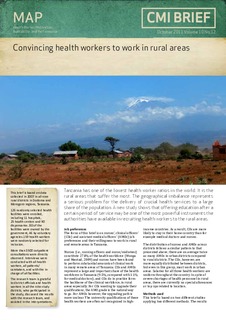| dc.contributor.author | Kolstad, Julie Riise | |
| dc.date.accessioned | 2018-01-04T08:20:14Z | |
| dc.date.available | 2018-01-04T08:20:14Z | |
| dc.date.issued | 2011-10-01 | |
| dc.identifier | oai:www.cmi.no:4210 | |
| dc.identifier.citation | Bergen: Chr. Michelsen Institute (CMI Brief vol. 10 no. 12) 4 p. | |
| dc.identifier.issn | 0809-6732 | |
| dc.identifier.uri | http://hdl.handle.net/11250/2475083 | |
| dc.description.abstract | Tanzania has one of the lowest health worker ratios in the world. It is the rural areas that suffer the most. The geographical imbalance represents a serious problem for the delivery of crucial health services to a large share of the population. A new study shows that offering education after a certain period of service may be one of the most powerful instruments the authorities have available in recruiting health workers to the rural areas. | |
| dc.language.iso | eng | |
| dc.publisher | Chr. Michelsen Institute | |
| dc.relation | CMI Brief | |
| dc.relation | 12 | |
| dc.relation.ispartof | CMI Brief | |
| dc.relation.ispartofseries | CMI Brief vol. 10 no. 12 | |
| dc.relation.uri | https://www.cmi.no/publications/4210-convincing-health-workers-to-work-in-rural-areas | |
| dc.subject | Tanzania | |
| dc.title | Convincing health workers to work in rural areas | |
| dc.type | Report | |
